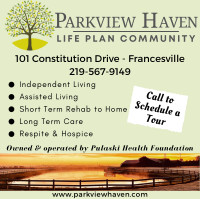Local News Briefs
PULASKI COUNTY - Indiana Department of Transportation contractor Superior Construction has closed SR 39 between CR 300 N and CR 200 N as of Monday, June 16.
SR 39 will be closed for approximately five weeks for a small structure replacement. Motorists should seek alternate routes. The official detour will follow SR 14, U.S. 421 and SR 10.
The Pulaski County Republican Party has issued a notice that it will hold a caucus at 9:15 a.m., Saturday, June 21, to fill a vacancy on the county council. The caucus will be held at the Pulaski County Public Library in Winamac.
Party chairman Kenneth Boswell reports Dist. 3 councilman Jerry Locke has resigned effective June 30. A former county commissioner, Locke joined the council in July 2022 to fill a vacancy. He was then elected to a four-year term in November that year. His successor will fill the remainder of that term through 2026.
Save on pre-sale tickets
WINAMAC - The Culpepper & Merriweather Circus is coming to Winamac Tuesday, June 17, at the Winamac Town Park for two shows, the first starting at 5:30 p.m., and the second beginning at 7 p.m. Each show lasts about an hour and a half.
The event is sponsored by the Winamac Kiwanis Club.
Pulaski County Farmers Market is open for the summer season with a weekly location in Winamac.
The Market features fresh produce, plus, local meats, maple syrup, honey, eggs, baked goods, sweet treats, cut flowers and coffee. The market will be open from 9 a.m. to 12 noon, Saturdays June through September, on Main Street in front of the courthouse in Winamac.
FRANCESVILLE – The Uptown Project, in partnership with West Central Youth League, will sponsor its “Family Fun in the Park,” from 6 p.m. to sunset, Saturday, June 28.
The public is welcome to join in for a fun evening of fellowship at the Francesville Town Park.
|
|
Indiana News
PERU - 4C Health is marking its 50th year in business with an exciting development for Pulaski County operations with the purchase of the Curtis Building from Pulaski Memorial Hospital.
The building is located north of Winamac, just off U.S. 35, at 2418 Curtis Drive.
WASHINGTON, D.C. (May 27) –Congressman Rudy Yakym honored two local first responders Tuesday recognizing their “exceptional service and commitment to their communities.”
Pulaski County Deputy Christopher Parish and Culver Community Police Chief Ryleigh Carr received entries into the Congressional Record.
WASHINGTON, D.C. (May 27) – U.S. Senators Todd Young (R-Ind.), Jeanne Shaheen (D-N.H.), and Kevin Cramer (R-N.D.) reintroduced the Mental Health Excellence in Schools Act to address the shortage of mental health providers in schools by boosting the pipeline of graduate students trained to become school psychologists, counselors, and social workers.
“Access to mental health resources improves the safety, well-being, and academic success of Hoosier students,” said Sen. Young. “Our bill will both support the school-based mental health workforce and address the critical need for these professionals.”
Pulaski County's unemployment rate dropped to 2.4 percent in April, down from 3.1 percent in March, the Indiana Department of Workforce Development reported Thursday, (May 22). The rate was 3.1 percent a year ago.
The county had 6,777 employed persons in a labor force of 6,943 in April. In March those numbers were 6,753 of 6,967. A year ago the numbers were 6,388 of 6.591.
|
|
Post News
Pulaski County stakeholders are leading an effort to develop a comprehensive Broadband plan for the county.
This plan will identify existing conditions, needs and gaps in high-speed internet (broadband) service within the county; set a long-term vision for broadband service; and provide actionable steps and implementation guidelines for broadband service.
WINAMAC - In 2023, a group of retired and active nurses, with the help of Pulaski Memorial Hospital, created a Nursing Honor Guard to assist families in honoring the compassion and dedication of nurses who have passed away - and celebrating their lives and service.
The Nursing Honor Guard is modeled after traditional military honor guards and pays tribute to the deeply personal and meaningful calling of the nursing profession.
The Community Foundation of Pulaski County (CFoPC) announced Thursday (June 5) $17,000 has been awarded in grants to four local nonprofits and community organizations.
The Foundation works to strengthen the community through funding, convening and fostering collaboration among nonprofits to amplify their impact.
WINAMAC - Winamac Community High School has announced its 2025 Senior Awards winners, honoring graduates for various academic and athletic awards, and scholarships.
The awards were presented at the annual Senior Awards program Friday evening (May 30).
Senior photos featured
WINAMAC - Commencement exercises for the Class of 2025 at Winamac Community High School were held Sunday June 1, at the high school gymnasium.
Diplomas were presented to 81 seniors.
|







